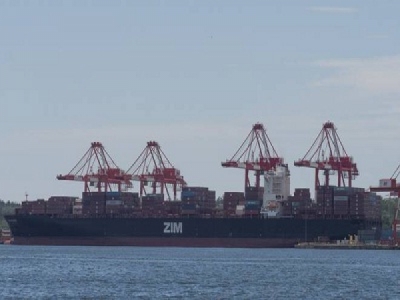
Posted on August 29, 2017
By Roger Taylor, Herald Business
Growth of Halifax’s container business lately has been good news for the Nova Scotia economy, but despite the signs of prosperity there is also a level of concern about the port’s ability to service an ever-expanding business.
While Halifax is an ice-free, deep-water port requiring little or no dredging, the key to the success of the city’s two container terminals is an ability to deliver the cargo efficiently and quickly to markets in central Canada and the United States.
In June, the largest container vessel ever to arrive at the Port of Halifax tied up at Halterm container terminal located in Halifax’s south end. To say the least, the Zim Antwerp is a huge ship, capable of carrying more than 10,000 containers, measured in 20-tonne-equivalent units.
It is a sign of the times. The Zim ship is one of the old-new breed of mega ships benefiting from the widening of the Panama Canal.
Having gigantic container vessels plying the world’s oceans has been dreamed about for many years but only now becoming widespread reality. So it isn’t surprising Halifax’s container terminals have seen a surge in container traffic over the last while, thus making Halifax one of the fastest growing ports on the East Coast.
Landings in Halifax are up but potential bottlenecks still exist for both rail and road transportation links to markets in central Canada and the United States, which could create serious issues for those trying to maintain a delivery schedule for freight destined for time-sensitive customers.
I’ve heard talk about moving both container operations across the harbour to the former Imperial Oil refinery, but there would likely be complaints about the increased rail traffic going through downtown Dartmouth and adding significantly to the truck traffic on the already busy Highway 111 isn’t likely to please many drivers who use the highway, also referred to as the Circumferential Highway.
There are some who believe expanding the existing Halterm facility, near Point Pleasant Park, to include the Ceres terminal operation is another option. Such a plan, I’ve heard, would have to include creating a new pier at Halterm and directing truck traffic down the rail cut through much of the residential south end.
Any changes to the Halifax port will likely cost billions and it will be the federal crown corporation, Halifax Port Corp., which will be asked to foot much of the bill.
There would likely be opposition to the south-end plan for various reasons, such as truck noise and changing the view of the harbour from Point Pleasant Park.
Meanwhile, the Cape Breton municipality has a plan it wants to implement, which would syphon off some of Halifax’s container business by creating a container terminal in the Point Edward area across the harbour from Sydney. The port, however, is not ice-free, it requires dredging and the rail line leading off the island is in disrepair.
Government at various levels would also likely be asked to provide financial support for the Cape Breton venture, making it less palatable.
There is yet another Nova Scotia container project, potentially located in Melford, Guysborough County.
It too has an ice-free harbour with deep-water access and because it is a Greenfield site, there are few restrictions on developing it as easy-to-access for both rail and truck traffic to the terminal.
Slowly, the Nova Scotia group backing the Melford Terminals project have been picking away at bringing the estimated $350-million, privately funded project to reality. The local investor group is supported by one of the largest terminal operators in the world, SSA Marine and private-equity firm Cyprus Capital Partners LP.
I have heard the Melford project’s goal is to begin construction of the terminal this year, but only if a major carrier could be attracted to bring its business to the Strait of Canso, and that may not be too far off.
A Melford container terminal would become the closest North American port for ships travelling from Asia, via the Suez Canal, and Europe. Rather than retrofitting the terminal to service the new super-sized vessels, the Melford Terminal will be specifically designed from the start to deal with such ships.
Although construction of a terminal at the Strait by the private sector makes a lot of sense for the Nova Scotia taxpayers and the economy, the one thing it doesn’t have is the same level of political clout that both Halifax and Cape Breton have on hand.
It should be interesting to see how Nova Scotia’s future port developments play out over the next little while.
Source: Herald Business





